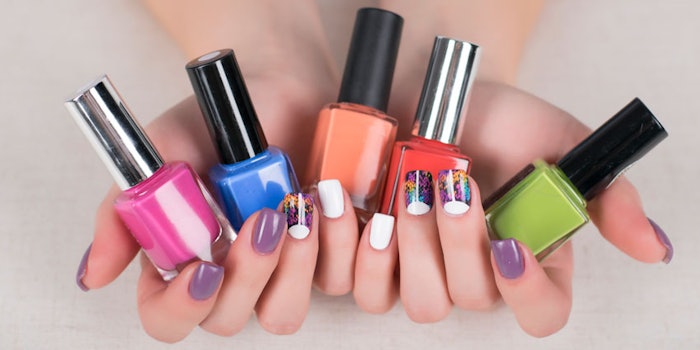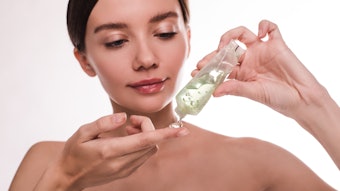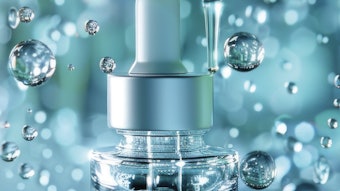
The fingernail or nail plate is a complex matrix comprising closely packed keratinized epithelial cells or onychocytes—cross-linked cysteine bond matrix proteins containing inorganic elements such as sulfur as well as calcium, sodium, iron, aluminum, copper, etc. In addition, the water content of a normal nail plate is typically between 10–30%, which acts as a plasticizer to the nail plate, providing increased flexibility. The thin layer of skin or cuticle at the base of fingernails protects the nail root and bed from environmental irritants and microorganisms from entering the nail fold surrounding the nail.
Various formulas have been developed to treat and decorate the cuticle and nail area. Moisturizers, exfoliants and serums, among others, target the cuticle to improve the condition of this thin layer of skin. Meanwhile, products such as strengtheners, ridge fillers and polishes are applied to protect, strengthen, smooth and impart color to the nail plate. The present discussion will focus on the components of typical nail polish formulations.
Key Nail Color Components
The key components for nail color cosmetics1 include polish consisting of a base coat, color, topcoat and nail- drying products, which can be applied separately or in specialized one-step products. As noted, nail polish is used primarily to protect and/or beautify nails, and consumers typically judge its performance by wearability, ease of use, gloss and application—e.g., drying time.
The base coat is designed to be applied to the nail first. It provides a proper substrate to which a color coat is applied. The base coat typically contains high levels of resin and lower viscosity plasticizers and is designed to prepare the nail by creating an adhesive, flexible, uniform film on the nail surface. After the base coat, the color coat or nail polish is applied and typically contains similar components as the base coat with the addition of dispersed color pigments. Finally, the topcoat is used to ensure a glossy finish that extends the durability of the color coat and reduces its dry time. The topcoat also contains high solids content resins and lower boiling point solvents. Some of the key materials used in nail coating formulas are as follows.
Resins: Resins are added to nail polish and topcoat formulas to enhance gloss and adhesion. These materials include natural ingredients such as nitrocellulose, shellac and dammar, and synthetic ingredients such as methacrylic copolymers and vinyl esters. Nitrocellulose is considered the workhorse resin for nail coatings and has been around since the 1920s, functioning as a durable film-former. The molecular weight of the polymeric nitrocellulose is critical; a lower molecular weight resin provides a more brittle film when solvents are removed, while a higher molecular weight with a longer chain length will be softer. The molecular weight can be directly correlated to the viscosity of the finished formula.
Further, the degree of nitration on the cellulosic nitrocellulose backbone will impact its solubility and explosive characteristics; specifically, less nitration is more soluble in polar solvents and more nitration is more explosive. However, nitrocellulose has drawbacks, particularly with respect to consumer safety and explosive manufacturing potential, although it is not particularly a concern in formulated nail care products.2 Also, nail polish compositions containing nitrocellulose can have poor long-wear characteristics and low gloss. This is because while the films have acceptable flexibility, they typically do not, without assistance from additives or co-resins, exhibit optimum adhesion to the nail because plasticizers are required to mar resistance and increase gloss.
Plasticizers: Added to modulate toughness and flexibility, plasticizers are used to optimize the final properties of the nail polish film formed. Such materials can include camphor, adipate, benzoate and citrate derivatives.
Solvents: Solvents are included in nail polish to act as carriers and provide liquid compositions with the desired brush qualities, viscosity modulation and play-time/dry-time. They are divided into categories of alcohols, i.e., isopropanol, butanol and ethanol; esters, such as acetates; and ketones—acetone, MEK, methyl isobutyl ketone. The key to selecting a solvent rests in the volatility profile balanced with amount of plasticizer and types of resins chosen; this is less an exact science than it is an art, or a trial and error process.
Pigments: Pigments used in nail polish can be divided into two categories: mineral types like titanium dioxide and iron oxides, and organic-types like Yellow No. 5 and the various lakes. While the main focus of this article is not specifically pigments, more detailed information is available elsewhere.3
Other additives: Various additives also are included in nail polish formulas to provide other unique properties. These additives may include rheology modifiers such as modified bentonite and hectorite clays; color stabilizers, i.e., benzophenone-1; and miscellaneous additives: sulfur amino acids to improve nail strength, fillers like titanium dioxide and nylon to level the film, fatty acids and other natural oils to soften the cuticle, and antifungal agents.
Nail Polish Patents
Nail polish, lacquer and polish remover formulations have not changed significantly in many years. However, recent patent literature provides insight into replacement options for nitro-cellulose, trends associated with natural or sustainable ingredients, and improvements in long-lasting wearability. The following patent applications provide a sampling of these modifications.
Nitrocellulose-free nail polish: In this patent application, Ortega et al.4 describe a nail polish composition comprising: at least one high gloss film-forming agent chosen from an esterified styrene-maleic anhydride copolymer, a non-esterified styrene-maleic anhydride copolymer and mixtures thereof; at least one co-film-forming agent chosen from an epoxy resin; optionally, at least one plasticizer; at least one solvent; and optionally, at least one colorant. This composition does not require nitro-cellulose and can be used to decorate or protect the nails. Said composition reportedly imparts good adhesion, long wear and high gloss to nail polish compositions.
Multi-layered color-enhancing nail appliqué: This invention by Park5 presents a novel approach to nail polish whereby the polish is applied dry, thus obviating the need for a liquid and avoiding the disadvantages associated with the application of a liquid product. The dry appliqué is comprised of liquid nail enamel applied to a substrate that, before the enamel is fully dried, is sealed with a protective film to prevent it from completely drying. The enamel thus fully cures on the fingernail once applied, similar to the manner in which conventional nail polish cures.
According to the patent, with liquid nail polish, more than one coat is often required to impart uniform color, which requires the user to wait for each coat to dry completely before applying another. The present invention is reported to provide a novel, multi-layered application including at least a bottom and a top layer. The bottom layer is designed to effectively hide the color of the natural nail while the top layer imparts a color. The top layer is thus uninfluenced by the color of a wearer’s natural nail and as a result, is said to appear brilliant and pure.
Method and formulation for coloring nails: In one embodiment of this technology described by Nelson et al.,6 the invention is a translucent nail polish glaze formulation comprising: ethyl acetate; butyl acetate; isopropyl alcohol; nitrocellulose; one or more chemicals selected from the group consisting of adipic acid, neopentyl glycol or trimellitic anhydride copolymer; trimethyl pentanyl diisobutyrate; triphenyl phosphate; stearalkonium hectorite; diacetone alcohol; citric acid; dimethicone; and benzophenone-1.
Further, the patent application states the translucent nail polish glaze further comprises one or more chemicals selected from: nacreous pigments, stearalkonium hectorite, titanium dioxide, mica, bismuth oxychloride, talc, iron oxides (red and black), Red No. 6 barium lake, Red No. 7 calcium lake, Red No. 34 calcium lake, Yellow No. 5 aluminum lake, ferric (ammonium) ferrocyanide, Violet No. 2, acrylates copolymer, polyethylene terephthalate, tosylamide, epoxy resin, N-butyl alcohol, SD Alcohol 40B, camphor and SD Alcohol 3-A.
Water-based nail polish composition: In this patent application from Malnou,7 the formulators sought to develop water-based nail polishes. According to the patent application, for this purpose, it is necessary to solve three primary problems: speed of drying and hardening of the film; brilliance of the film obtained; and adherence of the film to the nail. The most frequently proposed solutions are based on the use of dispersions or suspensions of polymers in water, preferably suspensions of acrylic copolymers, vinyl copolymers, polyesters, polyurethanes, etc. To form a cohesive film, the particles of these suspensions must coalesce, with or without the assistance of coalescent materials and/or plasticizers, and while coalescent solvents evaporate during drying, the plasticizing solvents remain primarily in the film. To solve these problems, the authors tested the use of suspensions of various polymers of different sizes and mixtures thereof; of suspensions of different hardness, i.e., glass transition temperatures, that are coalesced and/or plasticized by solvents of different natures having different boiling points; and of suspensions of different compositions, i.e., acrylic, vinyl, polyurethane, etc., or that use particular monomers.
This invention discloses a water-based nail-polish composition including: a) a mixture of at least one water-based suspension of hard nanoparticles of an acrylic polymer at a glass transition temperature > 55°C in combination with at least one coalescent and/or plasticizing solvent of the polymer; and b) at least one water-based suspension of nano-particles of partially cross-linked acrylic monomers that have a film-formation temperature < 15°C. The water-based composition may also contain a solution of an acrylic polymer of low molecular weight, i.e., approx. < 20,000, with a high acid value neutralized to a pH of between 7 and 8.5. The inventor found that a water-based composition having the acceptable properties for use in nail polish could be obtained from a mixture of the described polymers.
Amorphous poly lactic acid resin nail polish: The objective of this invention from Lin8 is to provide an amorphous poly lactic acid resin nail polish base material refined from plant material. When applied, the material can be mixed with nail polish color formulas (0.5%–5.0%), allowing the users to choose the nail polish color they want. This nail polish is also reportedly biodegradable.
Recent Commercial Launches
The term nail polish is interesting in that actual polishing typically does not occur when a color coating is applied to the nail. Many alternate descriptors are also used, such as nail lacquer, enamel, varnish, paint, etc.; all of which are interchangeable. As noted, while few changes have been made to product formulas in this market, recent launches have focused on the applicator brush, to ensure its shape, bristles and grip make the varnish easier to apply, as well as the development of nail polish pens with elastic tips and nonslip grip brushes.
In general, the global trends for this category can be summed up as addressing convenience, i.e. tailoring the product for a quick and easy application, as well as ensuring the product is durable. Regarding convenience, this trend responds to consumers’ busy lives since, while juggling family and work commitments, they have less time to dedicate to the care of their nails. Market claims include: no drying time necessary; control-flow brushes to ensure quick, smooth and even application—and with pens, in just one click; and instantly sealing nail color to form a high gloss shield to prevent polish smudges and smears.
Besides convenience, consumers want nail polish to last longer. Typical users apply nail varnish two or three times a week, thus claims related to longer-lasting products ensure the polish lasts a longer time without chipping or flaking—even between seven to ten days, in some cases, offering the user three times longer wear. Related claims include technical-sounding terminology such as color-lock formula, chip-resistant shield, and shock-resistant complex.
Following are some examples of recent launches in the nail care market. The information presented is taken from publicly available sources and is included for illustrative purposes only. The estimated ingredient ranges are provided as a starting point from which formulators can build their own unique formulas.
Elysambre nail polish: Elysambre nail polish (see Figure 1 and Table 1) is touted as containing no parabens, toluene, formol or colophane and has reportedly not been tested on animals. It is described as a nail polish that does not contain harsh, strong-smelling chemicals and is formulated with natural minerals to help provide a hard, durable, chip-free finish.
Sally Hansen Complete Salon Manicure nail polish: Sally Hansen Complete Salon Manicure nail polish (see Figure 2 and Table 2) is said to offer the five steps of a manicure in one product by acting as a base coat, strengthener, growth treatment, color and topcoat. The product is promoted as DBP- and formaldehyde-free and contains a technology to offer advanced wear, more shine and nourishing care.
Erre Due acetone-free nail polish remover: The Erre Due acetone-free nail polish remover (see Figure 3 and Table 3) has been formulated with emollients to protect, hydrate and care for nails while reportedly removing even the most persistent polish.
Formulator Beware
As can be seen from the examples provided, nail care products are increasingly touting the absence of controversial ingredients—in particular, substituting the so-called Big Three: toluene, formaldehyde and dibutyl phthalate. There is yet room in the marketplace—but certainly not on the label—for companies to provide clearer communication and explanations to the consumer regarding the above controversial ingredients and their safety in order to reassure consumers and limit confusion. Other trends to consider are continuing the quest for durability and convenience, which continue to become the top trends across all geographical regions, as well as adding components for UV protection and moisturizing/hydrating claims.
References
Send e-mail to [email protected].
1. ZD Draelos, Cosmetic Dermatology: Products and Procedures, ch 27, pg 206–215 in Colored Nail Cosmetics and Hardeners, Wiley-Blackwell/John Wiley and Son: West Sussex, UK (2010)
2. Storage and handling of industrial nitrocellulose, http://books.hse.gov.uk/hse/public/saleproduct.jsf?catalogueCode=9780717606948 (Accessed Mar 15, 2011)
3. Nail Preparation, ch 26 in The Chemistry and Manufacturing of Cosmetics, Third Edition, Volume II—Formulating, M. Schlossman, ed; Allured Business Media: Carol Stream, IL USA (2006)
4. US Patent Application 20100278766, Nitro-cellulose-free nail polish, L Ortega, et al. (Nov 4, 2010)
5. US Patent Application 20100212681, Multi-layered color-enhancing nail appliqué, FY Park (Aug 26, 2010)
6. US Patent Application 20100158836, Method and formulation for coloring nails, C Nelson et al (Jun 24, 2010)
7. US Patent Application 20090068131, Water-based nail-polish composition, A Malnou (Mar 12, 2009)
8. US Patent Application 20100099841, Amorphous poly lactic acid resin nail polish, J-M Lin (Apr 22, 2010)









